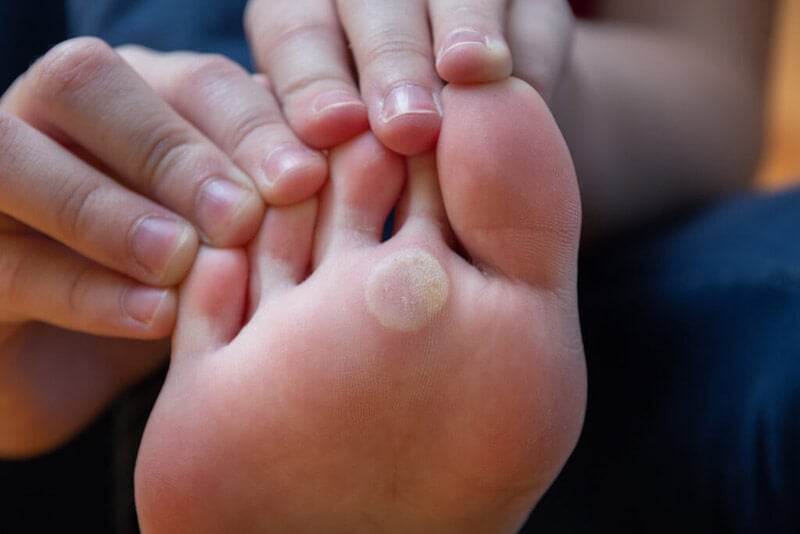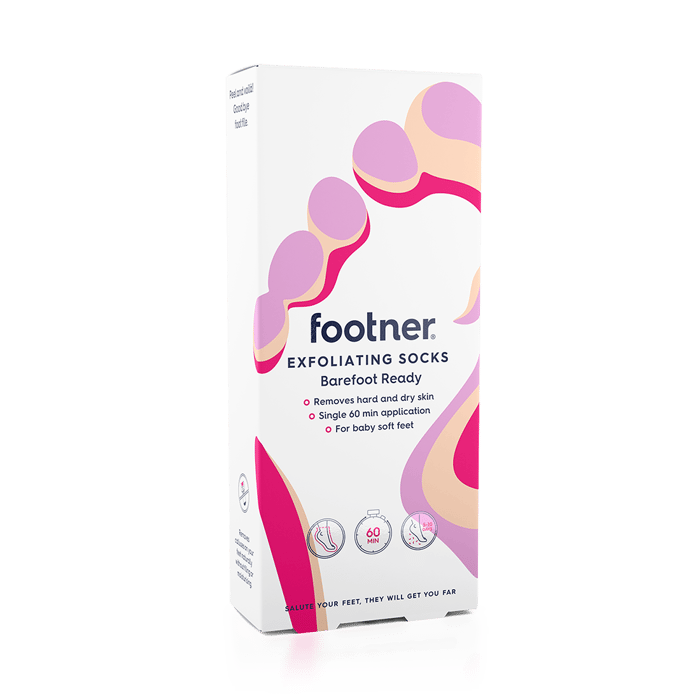Corns and Calluses
Corns and calluses are thick and/or hardened layers of skin that often develop on the feet. Although generally not serious, foot corns & callus can be painful and unsightly. They tend to occur as a protective response to friction and pressure, for example, because of wearing shoes that don’t fit you properly.
In most cases, corns on toes and feet can be treated at home, using methods such as a dead foot skin remover. However, in more severe instances, you might require medication or callus removal treatment from a foot specialist if they become infected.
This article covers some of the most common causes of foot corns & callus, as well as the symptoms to look out for. It also discusses effective methods of home treatment and types of corn remover.
What is the difference between a foot corn and a foot callus?
If you’re wondering what’s calluses and what’s corns, you’re not alone. Many people use the terms interchangeably; however, there are differences between the two.
Calluses
A callus is a thickened section of the outer layer of your skin, which forms as a result of pressure, friction or irritation. While it’s most common to get them on your feet, a callus on big toe or callus on ball of foot, they can actually occur anywhere on the body. As an example, having a callus on finger or your hand is frequent among people who play musical instruments. One common type of callus is a plantar callus, which forms on the sole of the foot.
Corns
A corn is a particular type of callus that’s made of dead skin. Having corns on feet is common, but it’s also possible to get corns on fingers. Corns can be categorised into three main types:
- Hard corn – these are usually small and develop in places with firm, hard skin, on bony areas of the foot, and in places where you have a callus
- Soft corn – these usually have a thinner surface and a more rubbery texture, may appear to be a whitish colour, and often develop as a corn in between toes
- Seed corns – these usually develop in clusters on the sole of the foot
Symptoms of foot corns & callus
Skin corns and calluses can present with a number of different symptoms depending on the type and severity. These include:
- A hardened bump on the skin
- A thick and rough patch of skin
- A feeling of pain or tenderness underneath the skin
- Dry, waxy or flaky skin
- Skin that turns yellow or white
- Pain when pressure is put on the area
In more serious cases, foot corns & callus may become irritated or infected. This could result in symptoms such as redness, a feeling of warmth in the area, severe pain, and fluid leaking from the corn or callus.

Causes of foot corns & callus
Calluses and corns on feet tend to develop as a result of pressure, friction, or irritation to the skin in that area. This can occur for several different reasons – some of the most common are listed below.
Wearing shoes that don’t fit well
This is the most common reason people develop foot corns & callus. If your shoes are too tight or too loose, they may rub against your foot and cause the skin to thicken as a protective measure. Narrow shoes often cause a pinky toe corn or corn on the big toe, and high heels also tend to compress the foot and increase the risk of calluses and corns on feet. Even if your shoes fit well, if there’s a poorly-positioned seam, this can rub against your foot and cause skin corns.
Not wearing socks
Wearing shoes without socks greatly increases the chances of your footwear rubbing against your skin and you developing foot corns & callus. Having socks that don’t fit you properly can also cause friction. If you walk outside barefoot a lot, this tends to result in thick skin on feet as the body tries to protect itself from injury. Over time, this could progress to a callus on ball of foot or corns on feet.
Risk factors
In addition to these direct causes, there are certain risk factors that can increase your chances of developing foot corns & callus. For example, these include having other foot-related conditions such as bunions, hammer toe, and bone spurs, having flat feet, walking a lot, and having diabetes.
Treatments and remedies for foot corns & callus
In the vast majority of cases, calluses and corns on feet are nothing serious and can be easily treated at home. This is especially true with small calluses and early-stage corns on feet.
It’s important to note that if you have diabetes or another underlying medical condition, you should consult your doctor before trying to treat foot corns & callus by yourself.
Home remedies for calluses and corns on toes and feet
There are a number of simple methods you can use to treat skin corns at home. These include:
- Using Footner Exfoliating Socks as a foot and callus peel to reduce hard skin and remove dead skin before it can develop into foot corns & callus
- Using a foot sander or heel scraper to regularly remove hard skin before calluses and corns on feet form
- Soaking calluses and corns on toes and the rest of your feet in warm water to soften the hardened skin
- Moisturising your feet regularly to keep the skin soft
- Wearing cushioned socks and shoes that fit well to prevent further friction and irritation to the skin
- Keeping your feet clean and dry
- Using over-the-counter corn pads to remove corns on feet
- Wearing special insoles and heel pads in your shoes
- Taking painkillers if your foot corns & callus are painful
You can normally expect to see a noticeable improvement within a week or two.
Medical corn remover and callus removal
In situations where your foot corns & callus are more severe and don’t go away with the above home remedies, you might need to look at medical corn removal and extreme foot callus removal. This can be done by a doctor or a foot specialist such as a podiatrist. Possible methods include:
- Cutting the calluses and corns on feet away
- Trimming foot corns & callus
- Applying a special patch with acid to soften the thickened skin of foot corns & callus
- In rare cases, surgery may be required (for example, if the friction is caused by a problem with bone alignment)
You should never attempt callus removal or cutting off corns by yourself, as this can lead to complications such as infection.
When should you see a doctor for foot corns & callus?
Normally you won’t need to go to the doctor for this type of condition, whether it’s a pinky toe corn or plantar callus. However, if any of the following apply, you should make an appointment:
- You suffer from diabetes
- You have problems with your circulation
- You suffer from heart disease
- Your foot corns & callus are bleeding or leaking pus or other discharge
- There has been no improvement in your foot corns & callus after trying home remedies for 3 weeks, or your condition is getting worse
- The pain from your calluses or corns on toes or feet is severe or preventing you from carrying out daily activities
The doctor will be able to diagnose you as definitely having foot corns & callus and prescribe the appropriate treatment. For example, if you have an infection, you may require antibiotics.
Preventing foot corns & callus
There are lots of effective steps you can take to help prevent foot corns & callus from developing in the first place. These include:
- Wearing shoes that fit you well and don’t rub your feet. Having your feet professionally measured can help with this. You should be able to wiggle your toes when wearing your shoes.
- Trying not to wear high heels or pointed shoes too often, especially when you have to walk a lot
- Always wearing socks underneath your shoes and choosing pairs that fit well and don’t rub against your skin
- Using Footner exfoliating socks, a heel scraper and/or a foot sander regularly to act as a hard and dead foot skin remover
- Moisturising your skin frequently to keep it soft
- Not walking outside barefoot, as this can lead to thick skin on feet
- Replacing your shoes before they get too worn out, as they won’t offer your feet as much protection
Corns and Calluses FAQs
What is the reason for corn in the foot?
The most common reason people develop foot corns & callus is from wearing shoes that don’t fit properly. High heels and narrow shoes are particularly likely to cause calluses and corns on toes and feet. The friction from the shoe rubbing against your foot results in the skin becoming thicker and harder, which over time can develop into skin corns and calluses.
How do you get rid of corns on feet?
The most effective way to get rid of foot corns & callus is to firstly remove the source of friction and pressure by wearing cushioned shoes that fit you properly. Then you want to focus on softening and removing the dead and hard skin. This can be done by wearing Footner exfoliating socks and using callus removal tools such as a heel scraper and/or foot sander.
Can you pull a corn out of your foot?
No, you should never attempt to cut off or pull out a corn or callous from your foot. If home remedies are not working for you, you should visit your doctor or a podiatrist who can use a corn remover or conduct callus removal safely. If you are diabetic, have poor circulation, are in severe pain, or think your foot corns & callus have become infected, book an appointment right away and don’t attempt to deal with the problem using home remedies.
Do corns go away on their own?
As long as the cause of friction or pressure on your foot is removed – for example, you change your shoes – then over time foot corns & callus can go away on their own. However, if you want to speed things up, you can use methods such as soaking your feet in warm water and gently removing the hard and dead skin with Footner exfoliating socks and other corn and callus removal products.
Why do corns hurt so much?
Corns hurt due to the irritation of the skin, nerves, and tissues that are constantly rubbed when you wear shoes, which puts pressure on the area.
Why do corns turn white?
Corns turn white after being treated with salicylic acid, which comes in drop, pad, and plaster form. This will turn the top layers of skin in the area white, and then you will be able to trim or peel away the dead tissue, which makes the corn flatter and less likely to cause you pain.
Links & Sources
- www.medicalnewstoday.com/articles/172459
- www.nhs.uk/conditions/corns-and-calluses/
- www.mayoclinic.org/diseases-conditions/corns-and-calluses/symptoms-causes/syc-20355946
- www.mayoclinic.org/diseases-conditions/corns-and-calluses/diagnosis-treatment/drc-20355951
- www.healthline.com/health/foot-corn
- www.webmd.com/skin-problems-and-treatments/understanding-corns-calluses-basics
- www.medicalnewstoday.com/articles/325993


